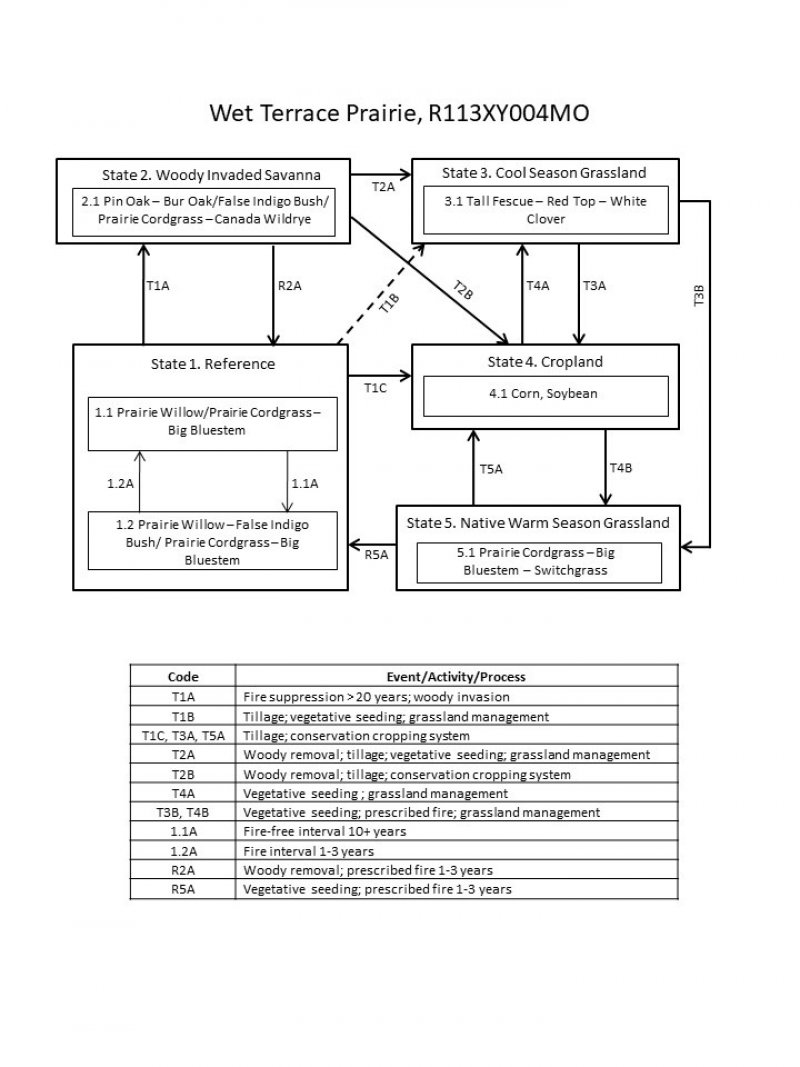
Natural Resources
Conservation Service
Ecological site R113XY004MO
Wet Terrace Prairie
Last updated: 5/17/2024
Accessed: 12/21/2025
General information
Provisional. A provisional ecological site description has undergone quality control and quality assurance review. It contains a working state and transition model and enough information to identify the ecological site.

Figure 1. Mapped extent
Areas shown in blue indicate the maximum mapped extent of this ecological site. Other ecological sites likely occur within the highlighted areas. It is also possible for this ecological site to occur outside of highlighted areas if detailed soil survey has not been completed or recently updated.
MLRA notes
Major Land Resource Area (MLRA): 113X–Central Claypan Areas
The western, Missouri portion of the Central Claypan is a weakly dissected till plain. Elevation ranges from about 1,000 feet in the north along the divide between the Missouri and Mississippi River watersheds to about 625 feet where the North Fork of the Salt River flows out of the area. Relief is generally low, with low slope gradients and relatively narrow drainageways. Most of the Central Claypan is in the Salt River watershed. The characteristic “claypan” occurs in the loess that caps the pre-Illinoisan aged till on the broad interfluves that characterize this region. Till is exposed on lower slopes. The underlying Mississippian aged limestone and Pennsylvanian aged shale is exposed in only a few places along lower slopes above the Salt River.
Classification relationships
Terrestrial Natural Community Type in Missouri (Nelson, 2010):
The reference state for this ecological site is most similar to a Wet-Mesic Bottomland Prairie.
National Vegetation Classification System Vegetation Association (NatureServe, 2010):
The reference state for this ecological site is most similar to Andropogon gerardii - Panicum virgatum - Helianthus grosseserratus Herbaceous Vegetation (CEGL002024).
Geographic relationship to the Missouri Ecological Classification System (Nigh & Schroeder, 2002):
This ecological site occurs throughout the Claypan Till Plains Subsection, and in adjacent Land Type Associations of the Wyaconda River Dissected Till Plains, Mississippi River Hills, and Chariton River Hills Subsections.
Ecological site concept
NOTE: This is a “provisional” Ecological Site Description (ESD) that is under development. It contains basic ecological information that can be used for conservation planning, application and land management. After additional information is collected, analyzed and reviewed, this ESD will be refined and published as “Approved”.
Wet Terrace Prairies are scattered throughout the MLRA and adjacent areas in river valleys of the major streams of the area, such as the Salt River and its tributaries. They are associated with floodplain ecological sites such as Loamy Floodplain Forest and Wet Floodplain Woodland, which are on lower positions closer to the stream channel. Adjacent upland sites are typically Till Savanna or Loess Prairie. Soils have a silty clay subsoil that perches water in the spring, and affects rooting depth and species composition. The reference plant community is prairie dominated by a dense cover of wetland species, including prairie cordgrass, sedges, and wetness-tolerant forbs.
Associated sites
| F109XY030MO |
Loamy Floodplain Forest Loamy Floodplain Forests are often on adjacent, lower floodplain positions. |
|---|---|
| R109XY031MO |
Wet Floodplain Prairie Wet Floodplain Prairies are often on adjacent, lower floodplain positions. |
| R109XY046MO |
Till Upland Savanna Till Upland Savannas are often upslope. |
| R113XY002MO |
Loess Upland Prairie Loess Upland Prairies are often upslope. |
Similar sites
| R113XY004MO |
Wet Terrace Prairie There are no similar Wet Terrace Prairie ecological sites in this MLRA. |
|---|
Table 1. Dominant plant species
| Tree |
Not specified |
|---|---|
| Shrub |
(1) Salix humilis |
| Herbaceous |
(1) Spartina pectinata |
Click on box and path labels to scroll to the respective text.
Ecosystem states
States 1 and 5 (additional transitions)
| T1A | - | Fire suppression greater than 20 years; woody invasion. |
|---|---|---|
| T1B | - | Tillage; vegetative seeding; grassland management. |
| T1C | - | Woody removal; tillage; seeding; conservation cropping system. |
| R2A | - | Woody species removal; prescribed fire 1-3 years |
| T2A | - | Woody species removal; tillage; vegetative seeding; grassland management |
| T2B | - | Woody species removal; tillage, conservation cropping system |
| T3A | - | Tillage; conservation cropping system |
| T3B | - | Vegetative seedling; prescribed fire; grassland management |
| T4A | - | Vegetative seeding; grassland management |
| T4B | - | Vegetative seeding; prescribed fire; grassland management |
| R5A | - | Vegetative seedling; prescribed fire 1-3 years |
| T5A | - | Tillage; conservation cropping system |
State 1 submodel, plant communities
| 1.1A | - | Fire free interval 10 plus years. |
|---|---|---|
| 1.2A | - | Fire interval 1-3 years. |

